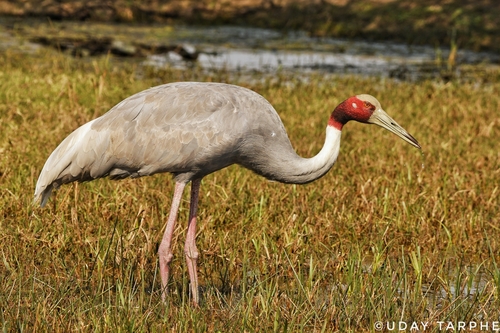
Sarus Crane
The Sarus Crane (Antigone antigone) is the world's tallest flying bird, renowned for its impressive size and striking appearance. It plays a significant role in wetland ecosystems, primarily as a top-level consumer, and is deeply embedded in the cultural landscape of South and Southeast Asia, often symbolizing marital fidelity and longevity. Its distinctive red head and neck, coupled with its overall grey plumage, make it easily identifiable. The species faces numerous conservation challenges, highlighting the importance of understanding its biology and ecology.
152-180 cm
Length
220-280 cm
Wingspan
Vulnerable
Conservation Status
Distribution
The Sarus Crane has three distinct populations: one in the Indian subcontinent, another in Southeast Asia, and a third in northern Australia. They are generally non-migratory, although some populations may undertake short-distance movements in response to water availability or breeding opportunities. They are found at low altitudinal ranges.
Lifespan
The lifespan in the wild is not well-documented, but in captivity, they can live for up to 40 years or more.
Sarus Crane's Habitat
Habitat Types
Wetlands, Marshes, Floodplains, Agricultural fields (particularly rice paddies)
Climate Zones
Tropical, Subtropical, Temperate (in some parts of its range)
Adaptations
Sarus Cranes have long legs and necks, which are ideal for wading in shallow water and foraging in dense vegetation. They have strong bills for probing and digging for food items.
Variations
There are three recognized subspecies: *A. a. antigone* (Indian subcontinent), *A. a. sharpii* (Southeast Asia), and *A. a. gillae* (Australia). These subspecies show some variations in size and plumage coloration.
Appearance
Breeding Plumage
Adult plumage is largely consistent throughout the year.
Seasonal Feather Changes
There are no significant seasonal variations in adult plumage.
Sex Based Plumage Differences
There is minimal sexual dimorphism in plumage; both sexes have grey body feathers and a distinctive red head and upper neck.
Notable Features
Bright red head and upper neck, contrasting with grey plumage., Long, pale greenish-grey legs., Dark grey or blackish primary feathers visible in flight., Bare, red skin patch extending down the neck.
Diet and Feeding
Primary Foods
Aquatic plants, Invertebrates (insects, crustaceans, mollusks), Small vertebrates (frogs, lizards, small snakes), Grains and seeds (especially in agricultural areas)
Foraging Behavior
Sarus Cranes forage by walking slowly through shallow water or fields, probing the mud or vegetation with their bills. They may also dig for tubers and roots.
Specializations
Their long bill and neck allow them to reach food items in deeper water or dense vegetation that other birds might not be able to access.
Seasonal Diet Variations
Their diet can vary seasonally depending on the availability of food. During the breeding season, they may consume more invertebrates to meet the protein needs of growing chicks. In the non-breeding season, they may rely more on grains and seeds, especially in agricultural landscapes.
Behavior
Social Structure
Sarus Cranes are typically found in pairs or small family groups. Outside of the breeding season, they may congregate in larger flocks, especially at good feeding sites.
Communication
Loud, trumpeting calls (used for territorial defense and pair bonding)., Unison calling (synchronized duets between mated pairs)., Visual displays (bowing, dancing, wing flapping).
Migration
Most populations are non-migratory, but some may undertake short-distance movements in response to seasonal changes in water availability.
Territorial or Group Behaviors
Pairs are highly territorial during the breeding season, defending their nesting area from other cranes. Outside of the breeding season, they are more tolerant of other cranes and may form larger flocks.
Conservation
Threats
Habitat loss and degradation (due to wetland drainage, agricultural expansion, and urbanization)., Pollution (pesticide contamination of wetlands and agricultural fields)., Human disturbance (at nesting sites)., Collision with power lines., Climate change (altering rainfall patterns and wetland availability).
Protection Programs
Protected areas (national parks and wildlife sanctuaries)., Community-based conservation initiatives., Habitat restoration projects., Awareness campaigns to reduce human disturbance.
Local National Laws
Protected under various national and international laws, including CITES (Appendix II).
Population Trend
Decreasing
Population Estimates
The global population is estimated to be around 15,000-20,000 individuals, with the majority in India.
Interesting Facts
Sarus Cranes are known for their lifelong pair bonds.
They are often seen as symbols of marital fidelity in many cultures.
Their unison calls can be heard from several kilometers away.
These calls are a key part of their courtship and territorial displays.
They are the only resident breeding crane in India.
Other crane species found in India are migratory visitors.
Faqs about Sarus Crane
What is the biggest threat to Sarus Cranes?
Habitat loss and degradation are the primary threats to Sarus Crane populations.
Are Sarus Cranes aggressive?
Sarus Cranes can be aggressive when defending their territory or young, but they generally avoid direct conflict with humans.
How can I help protect Sarus Cranes?
Support wetland conservation efforts, avoid disturbing nesting sites, and advocate for responsible agricultural practices that minimize pesticide use.
Copyright @ Nature Style Limited. All Rights Reserved.
 English
English